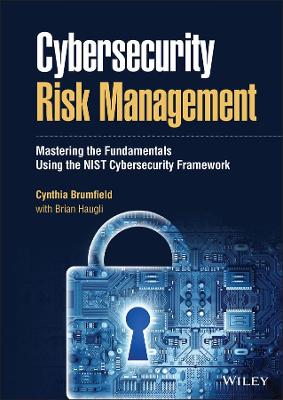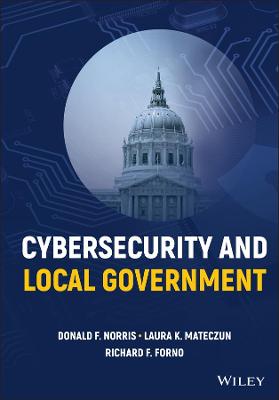Cybersecurity Risk Management
 -15%
portes grátis
-15%
portes grátis
Cybersecurity Risk Management
Mastering the Fundamentals Using the NIST Cybersecurity Framework
Brumfield, Cynthia; Haugli, Brian
John Wiley & Sons Inc
03/2022
176
Dura
Inglês
9781119816287
15 a 20 dias
510
Descrição não disponível.
Academic Foreword xiii
Acknowledgments xv
Preface - Overview of the NIST Framework xvii
Background on the Framework xviii
Framework Based on Risk Management xix
The Framework Core xix
Framework Implementation Tiers xxi
Framework Profile xxii
Other Aspects of the Framework Document xxiii
Recent Developments At Nist xxiii
Chapter 1 Cybersecurity Risk Planning and Management 1
Introduction 2
I. What Is Cybersecurity Risk Management? 2
A. Risk Management Is a Process 3
II. Asset Management 4
A. Inventory Every Physical Device and System You Have and Keep the Inventory Updated 5
B. Inventory Every Software Platform and Application You Use and Keep the Inventory Updated 9
C. Prioritize Every Device, Software Platform, and Application Based on Importance 10
D. Establish Personnel Security Requirements Including Third-Party Stakeholders 11
III. Governance 13
A. Make Sure You Educate Management about Risks 13
IV. Risk Assessment and Management 15
A. Know Where You're Vulnerable 15
B. Identify the Threats You Face, Both Internally and Externally 16
C. Focus on the Vulnerabilities and Threats That Are Most Likely AND Pose the Highest Risk to Assets 17
D. Develop Plans for Dealing with the Highest Risks 18
Summary 20
Chapter Quiz 20
Essential Reading on Cybersecurity Risk Management 22
Chapter 2 User and Network Infrastructure Planning and Management 23
I. Introduction 24
II. Infrastructure Planning and Management Is All about Protection, Where the Rubber Meets the Road 24
A. Identity Management, Authentication, and Access Control 25
1. Always Be Aware of Who Has Access to Which System, for Which Period of Time, and from Where the Access Is Granted 27
2. Establish, Maintain, and Audit an Active Control List and Process for Who Can Physically Gain Access to Systems 28
3. Establish Policies, Procedures, and Controls for Who Has Remote Access to Systems 28
4. Make Sure That Users Have the Least Authority Possible to Perform Their Jobs and Ensure That at Least Two Individuals Are Responsible for a Task 29
5. Implement Network Security Controls on All Internal Communications, Denying Communications among Various Segments Where Necessary 31
A Word about Firewalls 31
6. Associate Activities with a Real Person or a Single Specific Entity 32
7. Use Single- or Multi-Factor Authentication Based on the Risk Involved in the Interaction 33
III. Awareness and Training 34
A. Make Sure That Privileged Users and Security Personnel Understand Their Roles and Responsibilities 35
IV. Data Security 35
A. Protect the Integrity of Active and Archived Databases 35
B. Protect the Confidentiality and Integrity of Corporate Data Once It Leaves Internal Networks 36
C. Assure That Information Can Only Be Accessed by Those Authorized to Do So and Protect Hardware and Storage Media 37
D. Keep Your Development and Testing Environments Separate from Your Production Environment 38
E. Implement Checking Mechanisms to Verify Hardware Integrity 39
V. Information Protection Processes and Procedures 39
A. Create a Baseline of IT and OT Systems 40
B. Manage System Configuration Changes in a Careful, Methodical Way 41
A Word about Patch Management 42
C. Perform Frequent Backups and Test Your Backup Systems Often 43
D. Create a Plan That Focuses on Ensuring That Assets and Personnel Will Be Able to Continue to Function in the Event of a Crippling Attack or Disaster 43
VI. Mainte nance 44
A. Perform Maintenance and Repair of Assets and Log Activities Promptly 45
B. Develop Criteria for Authorizing, Monitoring, and Controlling All Maintenance and Diagnostic Activities for Third Parties 45
VII. Protective Technology 46
A. Restrict the Use of Certain Types of Media On Your Systems 46
B. Wherever Possible, Limit Functionality to a Single Function Per Device (Least Functionality) 47
C. Implement Mechanisms to Achieve Resilience on Shared Infrastructure 48
Summary 49
Chapter Quiz 50
Essential Reading on Network Management 51
Chapter 3 Tools and Techniques for Detecting Cyber Incidents 53
Introduction 54
What Is an Incident? 55
I. Detect 56
A. Anomalies and Events 56
1. Establish Baseline Data for Normal, Regular Traffic Activity and Standard Configuration for Network Devices 57
2. Monitor Systems with Intrusion Detection Systems and Establish a Way of Sending and Receiving Notifications of Detected Events; Establish a Means of Verifying, Assessing, and Tracking the Source of Anomalies 58
A Word about Antivirus Software 60
3. Deploy One or More Centralized Log File Monitors and Configure Logging Devices throughout the Organization to Send Data Back to the Centralized Log Monitor 61
4. Determine the Impact of Events Both Before and After they Occur 61
5. Develop a Threshold for How Many Times an Event Can Occur Before You Take Action 62
B. Continuous Monitoring 62
1. Develop Strategies for Detecting Breaches as Soon as Possible, Emphasizing Continuous Surveillance of Systems through Network Monitoring 63
2. Ensure That Appropriate Access to the Physical Environment Is Monitored, Most Likely through Electronic Monitoring or Alarm Systems 64
3. Monitor Employee Behavior in Terms of Both Physical and Electronic Access to Detect Unauthorized Access 65
4. Develop a System for Ensuring That Software Is Free of Malicious Code through Software Code Inspection and Vulnerability Assessments 65
5. Monitor Mobile Code Applications (e.g., Java Applets) for Malicious Activity by Authenticating the Codes' Origins, Verifying their Integrity, and Limiting the Actions they Can Perform 66
6. Evaluate a Provider's Internal and External Controls' Adequacy and Ensure they Develop and Adhere to Appropriate Policies, Procedures, and Standards; Consider the Results of Internal and External Audits 66
7. Monitor Employee Activity for Security Purposes and Assess When Unauthorized Access Occurs 67
8. Use Vulnerability Scanning Tools to Find Your Organization's Weaknesses 68
C. Detection Processes 68
1. Establish a Clear Delineation between Network and Security Detection, with the Networking Group and the Security Group Having Distinct and Different Responsibilities 69
2. Create a Formal Detection Oversight and Control Management Function; Define Leadership for a Security Review, Operational Roles, and a Formal Organizational Plan; Train Reviewers to Perform Their Duties Correctly and Implement the Review Process 70
3. Test Detection Processes Either Manually or in an Automated Fashion in Conformance with the Organization's Risk Assessment 71
4. Inform Relevant Personnel Who Must Use Data or Network Security Information about What Is Happening and Otherwise Facilitate Organizational Communication 71
5. Document the Process for Event Detection to Improve the Organization's Detection Systems 72
Summary 72
Chapter Quiz 73
Essential Reading for Tools and Techniques for Detecting a Cyberattack 74
Chapter 4 Developing a Continuity of Operations Plan 75
Introduction 77
A. One Size Does Not Fit All 77
I. Response 77
A. Develop an Executable Response Plan 79
B. Understand the Importance of Communications in Incident Response 80
C. Prepare for Corporate-Wide Involvement During Some Cybersecurity Attacks 81
II. Analysis 82
A. Examine Your Intrusion Detection System in Analyzing an Incident 82
B. Understand the Impact of the Event 83
C. Gather and Preserve Evidence 84
D. Prioritize the Treatment of the Incident Consistent with Your Response Plan 84
E. Establish Processes for Handling Vulnerability Disclosures 85
III. Mitigation 86
A. Take Steps to Contain the Incident 86
B. Decrease the Threat Level by Eliminating or Intercepting the Adversary as Soon as the Incident Occurs 87
C. Mitigate Vulnerabilities or Designate Them as Accepted Risk 88
IV. Recover 88
A. Recovery Plan Is Executed During or After a Cybersecurity Incident 89
B. Update Recovery Procedures Based on New Information as Recovery Gets Underway 91
C. Develop Relationships with Media to Accurately Disseminate Information and Engage in Reputational Damage Limitation 92
Summary 92
Chapter Quiz 93
Essential Reading for Developing a Continuity of Operations Plan 94
Chapter 5 Supply Chain Risk Management 95
Introduction 96
I. NIST Special Publication 800-161 96
II. Software Bill of Materials 97
III. NIST Revised Framework Incorporates Major Supply Chain Category 98
A. Identify, Establish, and Assess Cyber Supply Chain Risk Management Processes and Gain Stakeholder Agreement 98
B. Identify, Prioritize, and Assess Suppliers and Third-Party Partners of Suppliers 99
C. Develop Contracts with Suppliers and Third-Party Partners to Address Your Organization's Supply Chain Risk Management Goals 100
D. Routinely Assess Suppliers and Third-Party Partners Using Audits, Test Results, and Other Forms of Evaluation 101
E. Test to Make Sure Your Suppliers and Third-Party Providers Can Respond to and Recover from Service Disruption 102
Summary 103
Chapter Quiz 103
Essential Reading for Supply Chain Risk Management 104
Chapter 6 Manufacturing and Industrial Control Systems Security 105
Essential Reading on Manufacturing and Industrial Control Security 110
Appendix A: Helpful Advice for Small Organizations
Seeking to Implement Some of the Book's Recommendations 111
Appendix B: Critical Security Controls Version 8.0 Mapped to NIST CSF v1.1 113
Answers to Chapter Quizzes 121
Index 131
Acknowledgments xv
Preface - Overview of the NIST Framework xvii
Background on the Framework xviii
Framework Based on Risk Management xix
The Framework Core xix
Framework Implementation Tiers xxi
Framework Profile xxii
Other Aspects of the Framework Document xxiii
Recent Developments At Nist xxiii
Chapter 1 Cybersecurity Risk Planning and Management 1
Introduction 2
I. What Is Cybersecurity Risk Management? 2
A. Risk Management Is a Process 3
II. Asset Management 4
A. Inventory Every Physical Device and System You Have and Keep the Inventory Updated 5
B. Inventory Every Software Platform and Application You Use and Keep the Inventory Updated 9
C. Prioritize Every Device, Software Platform, and Application Based on Importance 10
D. Establish Personnel Security Requirements Including Third-Party Stakeholders 11
III. Governance 13
A. Make Sure You Educate Management about Risks 13
IV. Risk Assessment and Management 15
A. Know Where You're Vulnerable 15
B. Identify the Threats You Face, Both Internally and Externally 16
C. Focus on the Vulnerabilities and Threats That Are Most Likely AND Pose the Highest Risk to Assets 17
D. Develop Plans for Dealing with the Highest Risks 18
Summary 20
Chapter Quiz 20
Essential Reading on Cybersecurity Risk Management 22
Chapter 2 User and Network Infrastructure Planning and Management 23
I. Introduction 24
II. Infrastructure Planning and Management Is All about Protection, Where the Rubber Meets the Road 24
A. Identity Management, Authentication, and Access Control 25
1. Always Be Aware of Who Has Access to Which System, for Which Period of Time, and from Where the Access Is Granted 27
2. Establish, Maintain, and Audit an Active Control List and Process for Who Can Physically Gain Access to Systems 28
3. Establish Policies, Procedures, and Controls for Who Has Remote Access to Systems 28
4. Make Sure That Users Have the Least Authority Possible to Perform Their Jobs and Ensure That at Least Two Individuals Are Responsible for a Task 29
5. Implement Network Security Controls on All Internal Communications, Denying Communications among Various Segments Where Necessary 31
A Word about Firewalls 31
6. Associate Activities with a Real Person or a Single Specific Entity 32
7. Use Single- or Multi-Factor Authentication Based on the Risk Involved in the Interaction 33
III. Awareness and Training 34
A. Make Sure That Privileged Users and Security Personnel Understand Their Roles and Responsibilities 35
IV. Data Security 35
A. Protect the Integrity of Active and Archived Databases 35
B. Protect the Confidentiality and Integrity of Corporate Data Once It Leaves Internal Networks 36
C. Assure That Information Can Only Be Accessed by Those Authorized to Do So and Protect Hardware and Storage Media 37
D. Keep Your Development and Testing Environments Separate from Your Production Environment 38
E. Implement Checking Mechanisms to Verify Hardware Integrity 39
V. Information Protection Processes and Procedures 39
A. Create a Baseline of IT and OT Systems 40
B. Manage System Configuration Changes in a Careful, Methodical Way 41
A Word about Patch Management 42
C. Perform Frequent Backups and Test Your Backup Systems Often 43
D. Create a Plan That Focuses on Ensuring That Assets and Personnel Will Be Able to Continue to Function in the Event of a Crippling Attack or Disaster 43
VI. Mainte nance 44
A. Perform Maintenance and Repair of Assets and Log Activities Promptly 45
B. Develop Criteria for Authorizing, Monitoring, and Controlling All Maintenance and Diagnostic Activities for Third Parties 45
VII. Protective Technology 46
A. Restrict the Use of Certain Types of Media On Your Systems 46
B. Wherever Possible, Limit Functionality to a Single Function Per Device (Least Functionality) 47
C. Implement Mechanisms to Achieve Resilience on Shared Infrastructure 48
Summary 49
Chapter Quiz 50
Essential Reading on Network Management 51
Chapter 3 Tools and Techniques for Detecting Cyber Incidents 53
Introduction 54
What Is an Incident? 55
I. Detect 56
A. Anomalies and Events 56
1. Establish Baseline Data for Normal, Regular Traffic Activity and Standard Configuration for Network Devices 57
2. Monitor Systems with Intrusion Detection Systems and Establish a Way of Sending and Receiving Notifications of Detected Events; Establish a Means of Verifying, Assessing, and Tracking the Source of Anomalies 58
A Word about Antivirus Software 60
3. Deploy One or More Centralized Log File Monitors and Configure Logging Devices throughout the Organization to Send Data Back to the Centralized Log Monitor 61
4. Determine the Impact of Events Both Before and After they Occur 61
5. Develop a Threshold for How Many Times an Event Can Occur Before You Take Action 62
B. Continuous Monitoring 62
1. Develop Strategies for Detecting Breaches as Soon as Possible, Emphasizing Continuous Surveillance of Systems through Network Monitoring 63
2. Ensure That Appropriate Access to the Physical Environment Is Monitored, Most Likely through Electronic Monitoring or Alarm Systems 64
3. Monitor Employee Behavior in Terms of Both Physical and Electronic Access to Detect Unauthorized Access 65
4. Develop a System for Ensuring That Software Is Free of Malicious Code through Software Code Inspection and Vulnerability Assessments 65
5. Monitor Mobile Code Applications (e.g., Java Applets) for Malicious Activity by Authenticating the Codes' Origins, Verifying their Integrity, and Limiting the Actions they Can Perform 66
6. Evaluate a Provider's Internal and External Controls' Adequacy and Ensure they Develop and Adhere to Appropriate Policies, Procedures, and Standards; Consider the Results of Internal and External Audits 66
7. Monitor Employee Activity for Security Purposes and Assess When Unauthorized Access Occurs 67
8. Use Vulnerability Scanning Tools to Find Your Organization's Weaknesses 68
C. Detection Processes 68
1. Establish a Clear Delineation between Network and Security Detection, with the Networking Group and the Security Group Having Distinct and Different Responsibilities 69
2. Create a Formal Detection Oversight and Control Management Function; Define Leadership for a Security Review, Operational Roles, and a Formal Organizational Plan; Train Reviewers to Perform Their Duties Correctly and Implement the Review Process 70
3. Test Detection Processes Either Manually or in an Automated Fashion in Conformance with the Organization's Risk Assessment 71
4. Inform Relevant Personnel Who Must Use Data or Network Security Information about What Is Happening and Otherwise Facilitate Organizational Communication 71
5. Document the Process for Event Detection to Improve the Organization's Detection Systems 72
Summary 72
Chapter Quiz 73
Essential Reading for Tools and Techniques for Detecting a Cyberattack 74
Chapter 4 Developing a Continuity of Operations Plan 75
Introduction 77
A. One Size Does Not Fit All 77
I. Response 77
A. Develop an Executable Response Plan 79
B. Understand the Importance of Communications in Incident Response 80
C. Prepare for Corporate-Wide Involvement During Some Cybersecurity Attacks 81
II. Analysis 82
A. Examine Your Intrusion Detection System in Analyzing an Incident 82
B. Understand the Impact of the Event 83
C. Gather and Preserve Evidence 84
D. Prioritize the Treatment of the Incident Consistent with Your Response Plan 84
E. Establish Processes for Handling Vulnerability Disclosures 85
III. Mitigation 86
A. Take Steps to Contain the Incident 86
B. Decrease the Threat Level by Eliminating or Intercepting the Adversary as Soon as the Incident Occurs 87
C. Mitigate Vulnerabilities or Designate Them as Accepted Risk 88
IV. Recover 88
A. Recovery Plan Is Executed During or After a Cybersecurity Incident 89
B. Update Recovery Procedures Based on New Information as Recovery Gets Underway 91
C. Develop Relationships with Media to Accurately Disseminate Information and Engage in Reputational Damage Limitation 92
Summary 92
Chapter Quiz 93
Essential Reading for Developing a Continuity of Operations Plan 94
Chapter 5 Supply Chain Risk Management 95
Introduction 96
I. NIST Special Publication 800-161 96
II. Software Bill of Materials 97
III. NIST Revised Framework Incorporates Major Supply Chain Category 98
A. Identify, Establish, and Assess Cyber Supply Chain Risk Management Processes and Gain Stakeholder Agreement 98
B. Identify, Prioritize, and Assess Suppliers and Third-Party Partners of Suppliers 99
C. Develop Contracts with Suppliers and Third-Party Partners to Address Your Organization's Supply Chain Risk Management Goals 100
D. Routinely Assess Suppliers and Third-Party Partners Using Audits, Test Results, and Other Forms of Evaluation 101
E. Test to Make Sure Your Suppliers and Third-Party Providers Can Respond to and Recover from Service Disruption 102
Summary 103
Chapter Quiz 103
Essential Reading for Supply Chain Risk Management 104
Chapter 6 Manufacturing and Industrial Control Systems Security 105
Essential Reading on Manufacturing and Industrial Control Security 110
Appendix A: Helpful Advice for Small Organizations
Seeking to Implement Some of the Book's Recommendations 111
Appendix B: Critical Security Controls Version 8.0 Mapped to NIST CSF v1.1 113
Answers to Chapter Quizzes 121
Index 131
Este título pertence ao(s) assunto(s) indicados(s). Para ver outros títulos clique no assunto desejado.
cybersecurity implementation; cybersecurity; cyber risk management; digital risk management; nist cybersecurity framework; framework for improving cybersecurity of critical infrastructure; nist framework; nist cybersecurity; cyberattacks
Academic Foreword xiii
Acknowledgments xv
Preface - Overview of the NIST Framework xvii
Background on the Framework xviii
Framework Based on Risk Management xix
The Framework Core xix
Framework Implementation Tiers xxi
Framework Profile xxii
Other Aspects of the Framework Document xxiii
Recent Developments At Nist xxiii
Chapter 1 Cybersecurity Risk Planning and Management 1
Introduction 2
I. What Is Cybersecurity Risk Management? 2
A. Risk Management Is a Process 3
II. Asset Management 4
A. Inventory Every Physical Device and System You Have and Keep the Inventory Updated 5
B. Inventory Every Software Platform and Application You Use and Keep the Inventory Updated 9
C. Prioritize Every Device, Software Platform, and Application Based on Importance 10
D. Establish Personnel Security Requirements Including Third-Party Stakeholders 11
III. Governance 13
A. Make Sure You Educate Management about Risks 13
IV. Risk Assessment and Management 15
A. Know Where You're Vulnerable 15
B. Identify the Threats You Face, Both Internally and Externally 16
C. Focus on the Vulnerabilities and Threats That Are Most Likely AND Pose the Highest Risk to Assets 17
D. Develop Plans for Dealing with the Highest Risks 18
Summary 20
Chapter Quiz 20
Essential Reading on Cybersecurity Risk Management 22
Chapter 2 User and Network Infrastructure Planning and Management 23
I. Introduction 24
II. Infrastructure Planning and Management Is All about Protection, Where the Rubber Meets the Road 24
A. Identity Management, Authentication, and Access Control 25
1. Always Be Aware of Who Has Access to Which System, for Which Period of Time, and from Where the Access Is Granted 27
2. Establish, Maintain, and Audit an Active Control List and Process for Who Can Physically Gain Access to Systems 28
3. Establish Policies, Procedures, and Controls for Who Has Remote Access to Systems 28
4. Make Sure That Users Have the Least Authority Possible to Perform Their Jobs and Ensure That at Least Two Individuals Are Responsible for a Task 29
5. Implement Network Security Controls on All Internal Communications, Denying Communications among Various Segments Where Necessary 31
A Word about Firewalls 31
6. Associate Activities with a Real Person or a Single Specific Entity 32
7. Use Single- or Multi-Factor Authentication Based on the Risk Involved in the Interaction 33
III. Awareness and Training 34
A. Make Sure That Privileged Users and Security Personnel Understand Their Roles and Responsibilities 35
IV. Data Security 35
A. Protect the Integrity of Active and Archived Databases 35
B. Protect the Confidentiality and Integrity of Corporate Data Once It Leaves Internal Networks 36
C. Assure That Information Can Only Be Accessed by Those Authorized to Do So and Protect Hardware and Storage Media 37
D. Keep Your Development and Testing Environments Separate from Your Production Environment 38
E. Implement Checking Mechanisms to Verify Hardware Integrity 39
V. Information Protection Processes and Procedures 39
A. Create a Baseline of IT and OT Systems 40
B. Manage System Configuration Changes in a Careful, Methodical Way 41
A Word about Patch Management 42
C. Perform Frequent Backups and Test Your Backup Systems Often 43
D. Create a Plan That Focuses on Ensuring That Assets and Personnel Will Be Able to Continue to Function in the Event of a Crippling Attack or Disaster 43
VI. Mainte nance 44
A. Perform Maintenance and Repair of Assets and Log Activities Promptly 45
B. Develop Criteria for Authorizing, Monitoring, and Controlling All Maintenance and Diagnostic Activities for Third Parties 45
VII. Protective Technology 46
A. Restrict the Use of Certain Types of Media On Your Systems 46
B. Wherever Possible, Limit Functionality to a Single Function Per Device (Least Functionality) 47
C. Implement Mechanisms to Achieve Resilience on Shared Infrastructure 48
Summary 49
Chapter Quiz 50
Essential Reading on Network Management 51
Chapter 3 Tools and Techniques for Detecting Cyber Incidents 53
Introduction 54
What Is an Incident? 55
I. Detect 56
A. Anomalies and Events 56
1. Establish Baseline Data for Normal, Regular Traffic Activity and Standard Configuration for Network Devices 57
2. Monitor Systems with Intrusion Detection Systems and Establish a Way of Sending and Receiving Notifications of Detected Events; Establish a Means of Verifying, Assessing, and Tracking the Source of Anomalies 58
A Word about Antivirus Software 60
3. Deploy One or More Centralized Log File Monitors and Configure Logging Devices throughout the Organization to Send Data Back to the Centralized Log Monitor 61
4. Determine the Impact of Events Both Before and After they Occur 61
5. Develop a Threshold for How Many Times an Event Can Occur Before You Take Action 62
B. Continuous Monitoring 62
1. Develop Strategies for Detecting Breaches as Soon as Possible, Emphasizing Continuous Surveillance of Systems through Network Monitoring 63
2. Ensure That Appropriate Access to the Physical Environment Is Monitored, Most Likely through Electronic Monitoring or Alarm Systems 64
3. Monitor Employee Behavior in Terms of Both Physical and Electronic Access to Detect Unauthorized Access 65
4. Develop a System for Ensuring That Software Is Free of Malicious Code through Software Code Inspection and Vulnerability Assessments 65
5. Monitor Mobile Code Applications (e.g., Java Applets) for Malicious Activity by Authenticating the Codes' Origins, Verifying their Integrity, and Limiting the Actions they Can Perform 66
6. Evaluate a Provider's Internal and External Controls' Adequacy and Ensure they Develop and Adhere to Appropriate Policies, Procedures, and Standards; Consider the Results of Internal and External Audits 66
7. Monitor Employee Activity for Security Purposes and Assess When Unauthorized Access Occurs 67
8. Use Vulnerability Scanning Tools to Find Your Organization's Weaknesses 68
C. Detection Processes 68
1. Establish a Clear Delineation between Network and Security Detection, with the Networking Group and the Security Group Having Distinct and Different Responsibilities 69
2. Create a Formal Detection Oversight and Control Management Function; Define Leadership for a Security Review, Operational Roles, and a Formal Organizational Plan; Train Reviewers to Perform Their Duties Correctly and Implement the Review Process 70
3. Test Detection Processes Either Manually or in an Automated Fashion in Conformance with the Organization's Risk Assessment 71
4. Inform Relevant Personnel Who Must Use Data or Network Security Information about What Is Happening and Otherwise Facilitate Organizational Communication 71
5. Document the Process for Event Detection to Improve the Organization's Detection Systems 72
Summary 72
Chapter Quiz 73
Essential Reading for Tools and Techniques for Detecting a Cyberattack 74
Chapter 4 Developing a Continuity of Operations Plan 75
Introduction 77
A. One Size Does Not Fit All 77
I. Response 77
A. Develop an Executable Response Plan 79
B. Understand the Importance of Communications in Incident Response 80
C. Prepare for Corporate-Wide Involvement During Some Cybersecurity Attacks 81
II. Analysis 82
A. Examine Your Intrusion Detection System in Analyzing an Incident 82
B. Understand the Impact of the Event 83
C. Gather and Preserve Evidence 84
D. Prioritize the Treatment of the Incident Consistent with Your Response Plan 84
E. Establish Processes for Handling Vulnerability Disclosures 85
III. Mitigation 86
A. Take Steps to Contain the Incident 86
B. Decrease the Threat Level by Eliminating or Intercepting the Adversary as Soon as the Incident Occurs 87
C. Mitigate Vulnerabilities or Designate Them as Accepted Risk 88
IV. Recover 88
A. Recovery Plan Is Executed During or After a Cybersecurity Incident 89
B. Update Recovery Procedures Based on New Information as Recovery Gets Underway 91
C. Develop Relationships with Media to Accurately Disseminate Information and Engage in Reputational Damage Limitation 92
Summary 92
Chapter Quiz 93
Essential Reading for Developing a Continuity of Operations Plan 94
Chapter 5 Supply Chain Risk Management 95
Introduction 96
I. NIST Special Publication 800-161 96
II. Software Bill of Materials 97
III. NIST Revised Framework Incorporates Major Supply Chain Category 98
A. Identify, Establish, and Assess Cyber Supply Chain Risk Management Processes and Gain Stakeholder Agreement 98
B. Identify, Prioritize, and Assess Suppliers and Third-Party Partners of Suppliers 99
C. Develop Contracts with Suppliers and Third-Party Partners to Address Your Organization's Supply Chain Risk Management Goals 100
D. Routinely Assess Suppliers and Third-Party Partners Using Audits, Test Results, and Other Forms of Evaluation 101
E. Test to Make Sure Your Suppliers and Third-Party Providers Can Respond to and Recover from Service Disruption 102
Summary 103
Chapter Quiz 103
Essential Reading for Supply Chain Risk Management 104
Chapter 6 Manufacturing and Industrial Control Systems Security 105
Essential Reading on Manufacturing and Industrial Control Security 110
Appendix A: Helpful Advice for Small Organizations
Seeking to Implement Some of the Book's Recommendations 111
Appendix B: Critical Security Controls Version 8.0 Mapped to NIST CSF v1.1 113
Answers to Chapter Quizzes 121
Index 131
Acknowledgments xv
Preface - Overview of the NIST Framework xvii
Background on the Framework xviii
Framework Based on Risk Management xix
The Framework Core xix
Framework Implementation Tiers xxi
Framework Profile xxii
Other Aspects of the Framework Document xxiii
Recent Developments At Nist xxiii
Chapter 1 Cybersecurity Risk Planning and Management 1
Introduction 2
I. What Is Cybersecurity Risk Management? 2
A. Risk Management Is a Process 3
II. Asset Management 4
A. Inventory Every Physical Device and System You Have and Keep the Inventory Updated 5
B. Inventory Every Software Platform and Application You Use and Keep the Inventory Updated 9
C. Prioritize Every Device, Software Platform, and Application Based on Importance 10
D. Establish Personnel Security Requirements Including Third-Party Stakeholders 11
III. Governance 13
A. Make Sure You Educate Management about Risks 13
IV. Risk Assessment and Management 15
A. Know Where You're Vulnerable 15
B. Identify the Threats You Face, Both Internally and Externally 16
C. Focus on the Vulnerabilities and Threats That Are Most Likely AND Pose the Highest Risk to Assets 17
D. Develop Plans for Dealing with the Highest Risks 18
Summary 20
Chapter Quiz 20
Essential Reading on Cybersecurity Risk Management 22
Chapter 2 User and Network Infrastructure Planning and Management 23
I. Introduction 24
II. Infrastructure Planning and Management Is All about Protection, Where the Rubber Meets the Road 24
A. Identity Management, Authentication, and Access Control 25
1. Always Be Aware of Who Has Access to Which System, for Which Period of Time, and from Where the Access Is Granted 27
2. Establish, Maintain, and Audit an Active Control List and Process for Who Can Physically Gain Access to Systems 28
3. Establish Policies, Procedures, and Controls for Who Has Remote Access to Systems 28
4. Make Sure That Users Have the Least Authority Possible to Perform Their Jobs and Ensure That at Least Two Individuals Are Responsible for a Task 29
5. Implement Network Security Controls on All Internal Communications, Denying Communications among Various Segments Where Necessary 31
A Word about Firewalls 31
6. Associate Activities with a Real Person or a Single Specific Entity 32
7. Use Single- or Multi-Factor Authentication Based on the Risk Involved in the Interaction 33
III. Awareness and Training 34
A. Make Sure That Privileged Users and Security Personnel Understand Their Roles and Responsibilities 35
IV. Data Security 35
A. Protect the Integrity of Active and Archived Databases 35
B. Protect the Confidentiality and Integrity of Corporate Data Once It Leaves Internal Networks 36
C. Assure That Information Can Only Be Accessed by Those Authorized to Do So and Protect Hardware and Storage Media 37
D. Keep Your Development and Testing Environments Separate from Your Production Environment 38
E. Implement Checking Mechanisms to Verify Hardware Integrity 39
V. Information Protection Processes and Procedures 39
A. Create a Baseline of IT and OT Systems 40
B. Manage System Configuration Changes in a Careful, Methodical Way 41
A Word about Patch Management 42
C. Perform Frequent Backups and Test Your Backup Systems Often 43
D. Create a Plan That Focuses on Ensuring That Assets and Personnel Will Be Able to Continue to Function in the Event of a Crippling Attack or Disaster 43
VI. Mainte nance 44
A. Perform Maintenance and Repair of Assets and Log Activities Promptly 45
B. Develop Criteria for Authorizing, Monitoring, and Controlling All Maintenance and Diagnostic Activities for Third Parties 45
VII. Protective Technology 46
A. Restrict the Use of Certain Types of Media On Your Systems 46
B. Wherever Possible, Limit Functionality to a Single Function Per Device (Least Functionality) 47
C. Implement Mechanisms to Achieve Resilience on Shared Infrastructure 48
Summary 49
Chapter Quiz 50
Essential Reading on Network Management 51
Chapter 3 Tools and Techniques for Detecting Cyber Incidents 53
Introduction 54
What Is an Incident? 55
I. Detect 56
A. Anomalies and Events 56
1. Establish Baseline Data for Normal, Regular Traffic Activity and Standard Configuration for Network Devices 57
2. Monitor Systems with Intrusion Detection Systems and Establish a Way of Sending and Receiving Notifications of Detected Events; Establish a Means of Verifying, Assessing, and Tracking the Source of Anomalies 58
A Word about Antivirus Software 60
3. Deploy One or More Centralized Log File Monitors and Configure Logging Devices throughout the Organization to Send Data Back to the Centralized Log Monitor 61
4. Determine the Impact of Events Both Before and After they Occur 61
5. Develop a Threshold for How Many Times an Event Can Occur Before You Take Action 62
B. Continuous Monitoring 62
1. Develop Strategies for Detecting Breaches as Soon as Possible, Emphasizing Continuous Surveillance of Systems through Network Monitoring 63
2. Ensure That Appropriate Access to the Physical Environment Is Monitored, Most Likely through Electronic Monitoring or Alarm Systems 64
3. Monitor Employee Behavior in Terms of Both Physical and Electronic Access to Detect Unauthorized Access 65
4. Develop a System for Ensuring That Software Is Free of Malicious Code through Software Code Inspection and Vulnerability Assessments 65
5. Monitor Mobile Code Applications (e.g., Java Applets) for Malicious Activity by Authenticating the Codes' Origins, Verifying their Integrity, and Limiting the Actions they Can Perform 66
6. Evaluate a Provider's Internal and External Controls' Adequacy and Ensure they Develop and Adhere to Appropriate Policies, Procedures, and Standards; Consider the Results of Internal and External Audits 66
7. Monitor Employee Activity for Security Purposes and Assess When Unauthorized Access Occurs 67
8. Use Vulnerability Scanning Tools to Find Your Organization's Weaknesses 68
C. Detection Processes 68
1. Establish a Clear Delineation between Network and Security Detection, with the Networking Group and the Security Group Having Distinct and Different Responsibilities 69
2. Create a Formal Detection Oversight and Control Management Function; Define Leadership for a Security Review, Operational Roles, and a Formal Organizational Plan; Train Reviewers to Perform Their Duties Correctly and Implement the Review Process 70
3. Test Detection Processes Either Manually or in an Automated Fashion in Conformance with the Organization's Risk Assessment 71
4. Inform Relevant Personnel Who Must Use Data or Network Security Information about What Is Happening and Otherwise Facilitate Organizational Communication 71
5. Document the Process for Event Detection to Improve the Organization's Detection Systems 72
Summary 72
Chapter Quiz 73
Essential Reading for Tools and Techniques for Detecting a Cyberattack 74
Chapter 4 Developing a Continuity of Operations Plan 75
Introduction 77
A. One Size Does Not Fit All 77
I. Response 77
A. Develop an Executable Response Plan 79
B. Understand the Importance of Communications in Incident Response 80
C. Prepare for Corporate-Wide Involvement During Some Cybersecurity Attacks 81
II. Analysis 82
A. Examine Your Intrusion Detection System in Analyzing an Incident 82
B. Understand the Impact of the Event 83
C. Gather and Preserve Evidence 84
D. Prioritize the Treatment of the Incident Consistent with Your Response Plan 84
E. Establish Processes for Handling Vulnerability Disclosures 85
III. Mitigation 86
A. Take Steps to Contain the Incident 86
B. Decrease the Threat Level by Eliminating or Intercepting the Adversary as Soon as the Incident Occurs 87
C. Mitigate Vulnerabilities or Designate Them as Accepted Risk 88
IV. Recover 88
A. Recovery Plan Is Executed During or After a Cybersecurity Incident 89
B. Update Recovery Procedures Based on New Information as Recovery Gets Underway 91
C. Develop Relationships with Media to Accurately Disseminate Information and Engage in Reputational Damage Limitation 92
Summary 92
Chapter Quiz 93
Essential Reading for Developing a Continuity of Operations Plan 94
Chapter 5 Supply Chain Risk Management 95
Introduction 96
I. NIST Special Publication 800-161 96
II. Software Bill of Materials 97
III. NIST Revised Framework Incorporates Major Supply Chain Category 98
A. Identify, Establish, and Assess Cyber Supply Chain Risk Management Processes and Gain Stakeholder Agreement 98
B. Identify, Prioritize, and Assess Suppliers and Third-Party Partners of Suppliers 99
C. Develop Contracts with Suppliers and Third-Party Partners to Address Your Organization's Supply Chain Risk Management Goals 100
D. Routinely Assess Suppliers and Third-Party Partners Using Audits, Test Results, and Other Forms of Evaluation 101
E. Test to Make Sure Your Suppliers and Third-Party Providers Can Respond to and Recover from Service Disruption 102
Summary 103
Chapter Quiz 103
Essential Reading for Supply Chain Risk Management 104
Chapter 6 Manufacturing and Industrial Control Systems Security 105
Essential Reading on Manufacturing and Industrial Control Security 110
Appendix A: Helpful Advice for Small Organizations
Seeking to Implement Some of the Book's Recommendations 111
Appendix B: Critical Security Controls Version 8.0 Mapped to NIST CSF v1.1 113
Answers to Chapter Quizzes 121
Index 131
Este título pertence ao(s) assunto(s) indicados(s). Para ver outros títulos clique no assunto desejado.







